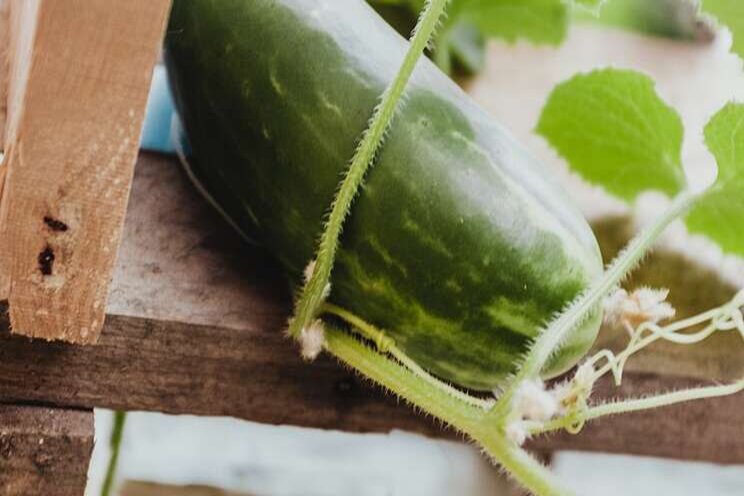High-wire growing can take cucumbers to the next level
Added on 12 March 2020

Finally, growers need to run an economic, sustainable, and successful business. In cucumbers, this has led to a state-of-the-art growing method: high-wire training.
What Does Hire-Wire Mean for Growers?
The high-wire system enables fully controlled, balanced, and self-determined plant management in which growers can manage the production of their high-quality cucumbers. In a hire-wire system, the cucumber plants keep on growing upwards during the whole season. All fruits are produced at the main stem. This results in better, easier-to-manage plant growth and more uniform cucumbers that have a longer shelflife. Most existing greenhouses are already suitable for high-wire cultivation, which requires a minimum height of about 14˝ feet.
Those are the basics, but how does this system help growers? Here are three ways, for starters.
1. High piece production and higher profit
High wire clearly stands for high production. For example, a Canadian grower can usually harvest 150 to 160 fruits of cucumbers per square foot in umbrella cultivation. This can increase to 180 to 220 fruits for high-wire cultivation. Some growers with growing lights are even achieving 270 to 300 fruits today. High-piece production is key in a high-wire system. Growers will face a cost increase, especially labor costs, which need to be counterbalanced by a high-piece production, leading to a higher income and profit.
2. Plannable and more efficient labor
Hire-wire is known for higher labor costs per square foot compared to umbrella cultivation. Clipping/lowering the plant head is, of course, a factor that has a huge impact on labor costs in high-wire cultivation. High-wire growers need to spend more time on pruning and picking the leaves. In the high-wire system, growers can plan their workload. They can harvest during the whole season, and the labor in the crop is easier to manage with consistent work when compared to the traditional style of farming. This increases efficiency in different crop-handling activities.
3. Year-round, high-quality fruit
In a high-wire crop, you can manage the amount of cucumbers on a plant. By pruning, you can keep your plant balanced and selective. The grow-out period is shorter than umbrella cultivation and is almost the same for all cucumbers. This results in higher quality and better shelf-life of high-wire cucumbers.
Genetic Profile of Seed Varieties
High-wire cultivation stands for market-driven and market-focused production: growers can forecast their production. The success of high-wire cultivation depends on the specific traits of the chosen cucumber varieties. High-wire requires a labor-friendly plant type. Plants must have small, open, horizontally positioned leaves and short, compact internodes with a higher photosynthetic activity. In addition, high-wire plants need to be excellent in vigor.
As more growers step into high-wire, more experience can be collected. The industry will benefit from internationally developed knowledge: current issues will be tackled better, and from a production perspective, high-wire production is still far away from its limit.
Hire-Wire System vs. Umbrella System
The following pictures illustrate the main differences between high-wire growing and umbrella cultivation.

Example of high-wire training system for cucumbers.Diagram courtesy of BASF/Nunhems
High-Wire System
- Regular lowering of the heads to keep the main stem production during the whole growing season
- Fruits always harvested at the same height
- Uniform follow-up of cucumbers (selectivity)
- Small leaves
- Open, clear arranged crop
- Uniform fruits

Example of umbrella cultivation for cucumbers.
Diagram courtesy of BASF/Nunhems
Umbrella Cultivation
- Main stem and lateral production (topped plants at the wire)
- Many cucumbers maturing at the same time
- Variable fruit quality
- Big leaves
- Dense, unarranged crop in the second part of the production period
Advantages and Challenges of High-Wire Cultivation in a Nutshell
Advantages
- Up to 25% higher yield without artificial lighting
- Market driven/plannable production
- Plannable, more constant and efficient labor
- Year-round, high fruit quality (uniform fruits, long shelf life)
- Production limits have not been reached yet
- Lower fixed costs per cucumber
Challenges
- Switching to hire-wire needs investment (if greenhouse does not yet fulfill the basic requirements)
- More risk due to higher labor costs. A high piece production is necessary.
- Because the plants need to be kept healthy for a longer period, virus and disease control is also needed longer.
Source: Greenhouse Grower
Photo by Bernard Hermant on Unsplash
Source: Greenhouse Grower
More news















